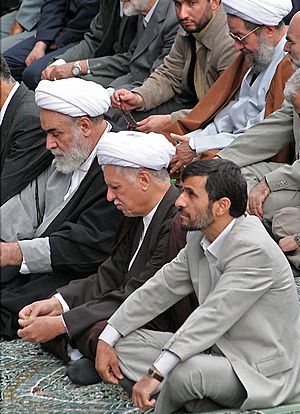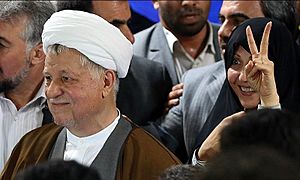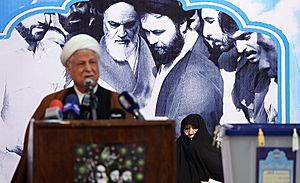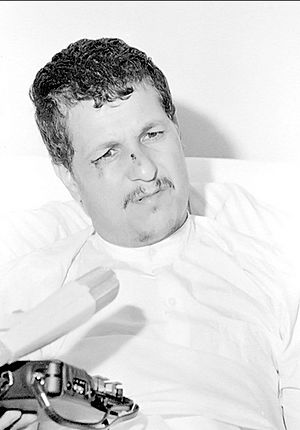Akbar Hashemi Rafsanjani facts for kids
Quick facts for kids
Akbar Hashemi Rafsanjani
|
|
|---|---|
|
اکبر هاشمی رفسنجانی
|
|
 |
|
| 4th President of Iran | |
| In office 16 August 1989 – 3 August 1997 |
|
| Supreme Leader | Ali Khamenei |
| First Vice President | Hassan Habibi |
| Preceded by | Ali Khamenei |
| Succeeded by | Mohammad Khatami |
| Chairman of Expediency Discernment Council | |
| In office 4 October 1989 – 8 January 2017 |
|
| Appointed by | Ali Khamenei |
| Preceded by | Ali Khamenei |
| Succeeded by | Mahmoud Hashemi Shahroudi |
| Chairman of the Assembly of Experts | |
| In office 25 July 2007 – 8 March 2011 |
|
| Supreme Leader | Ali Khamenei |
| Preceded by | Ali Meshkini |
| Succeeded by | Mohammad-Reza Mahdavi Kani |
| 18th Speaker of the Parliament of Iran | |
| In office 28 July 1980 – 3 August 1989 |
|
| First Deputy |
See list
|
| Preceded by | Javad Saeed |
| Succeeded by | Mehdi Karroubi |
| Member of the Assembly of Experts | |
| In office 15 August 1983 – 8 January 2017 |
|
| Constituency | Tehran Province |
| Majority | 2,301,492 (5th term) |
| Tehran's Friday Prayer Temporary Imam | |
| In office 3 July 1981 – 17 July 2009 |
|
| Appointed by | Ruhollah Khomeini |
| Member of the Parliament of Iran | |
| In office 28 May 1980 – 3 August 1989 |
|
| Constituency | Tehran, Rey, Shemiranat and Eslamshahr |
| Majority | 1,891,264 (81.9%; 2nd term) |
| Minister of Interior | |
| Acting 17 November 1979 – 27 February 1980 |
|
| Appointed by | Islamic Revolution Council |
| Preceded by | Hashem Sabbaghian |
| Succeeded by | Mohammad-Reza Mahdavi Kani |
| Personal details | |
| Born |
Akbar Hashemi Bahramani
25 August 1934 Bahreman, Imperial State of Persia |
| Died | 8 January 2017 (aged 82) Tajrish, Shemiran, Iran |
| Resting place | Mausoleum of Ruhollah Khomeini |
| Political party | Executives of Construction Party |
| Other political affiliations |
Islamic Republican Party (1979–1987) Combatant Clergy Association (1987–1996) |
| Spouse |
Effat Marashi
(m. 1958) |
| Children |
|
| Signature |  |
| Military service | |
| Commands | Second-in-Command of Iran's Joint Chiefs of Staff |
| Battles/wars | Iran–Iraq War |
| Awards | Order of Fath (1st grade) |
Akbar Hashemi Rafsanjani (born Akbar Hashemi Bahramani, 25 August 1934 – 8 January 2017) was an important Iranian politician. He was one of the people who helped create the Islamic Republic of Iran. He served as the fourth president of Iran from 1989 to 1997.
During his long career, Rafsanjani held many powerful roles. He was the speaker of parliament and a commander during the Iran–Iraq War. He also led the Assembly of Experts and the Expediency Discernment Council. Because of his strong influence, people sometimes called him "Akbar Shah."
Rafsanjani became president after winning elections in 1989 and 1993. He tried for a third term in 2005 but lost. He passed away in 2017 at the age of 82. While officials said he died from a heart attack, some people, including his family, wondered if something else happened.
Rafsanjani was known for his practical approach to politics. He supported a free market economy in Iran. He also wanted Iran to have better relationships with other countries, especially in the West. He helped start Islamic Azad University, a large university system in Iran.
Contents
Early Life and Education
Akbar Hashemi Rafsanjani was born on 25 August 1934. His family lived in the village of Bahreman near Rafsanjan in Kerman Province, Iran. They were wealthy pistachio farmers. His father, Mirza Ali Hashemi Behramani, was a well-known pistachio merchant.
When he was 14, Rafsanjani left home to study theology in Qom. There, he learned from important religious leaders. He became a student of Ayatollah Ruhollah Khomeini, who later founded the Islamic Republic.
Political Journey
Before the Revolution
While studying, Rafsanjani became interested in politics. He joined the movement against Mohammad Reza Shah, the ruler of Iran at the time. He supported Ayatollah Khomeini's ideas.
Because of his activities against the Shah's government, Rafsanjani was arrested many times. He spent over four years in jail between 1960 and 1979. Khomeini trusted him to manage the money for the revolutionary movement.
After the Revolution
After the Iranian Revolution succeeded in 1979, Rafsanjani became a key figure in the new government. He was part of the Council of Islamic Revolution. He also served as acting interior minister.
He helped create the Islamic Republican Party and later suggested it be dissolved. His sharp political skills and Khomeini's trust made him one of the most powerful politicians in Iran. He was very close to Khomeini, acting as his "eyes and ears." He also helped establish the Islamic Revolutionary Guard Corps.
Rafsanjani became one of the Tehran's Friday Prayer Imams, leading prayers for 30 years. He also played a big role in ending the Iran–Iraq War. He convinced Khomeini to agree to a ceasefire, which ended the eight-year conflict.
Leading the Parliament (1980–1989)
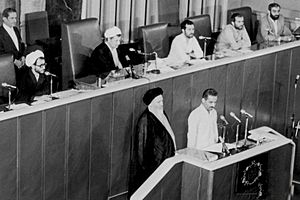
Rafsanjani helped create Iran's first election law. He was elected to the Parliament of Iran in 1980. He served as the Speaker of Parliament for nine years. He was Speaker during the first and second terms of Parliament after the revolution.
He had a major role in removing Abolhassan Banisadr as Iran's first president in 1981. He also helped create the Expediency Discernment Council. This council helps resolve disagreements between the Parliament and the Guardian Council. Rafsanjani later became the chairman of this council.
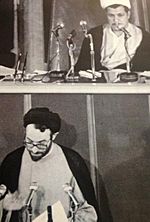
After the death of Ayatollah Khomeini in 1989, Rafsanjani decided to run for president. He won the election and left his role as Speaker of Parliament.
Becoming President (1989–1997)
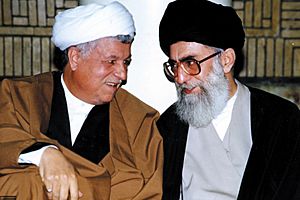
As president, Rafsanjani focused on rebuilding Iran after the war with Iraq. He believed in an "economy-first" approach. He supported allowing private businesses to take over state-owned industries. His goal was to create a modern, industrial economy that was connected to the global market.
Domestic Policy
Rafsanjani pushed for a free market economy. He wanted to make Iran's economy stronger. He encouraged universities to work with industries to help the country grow. He also started projects like Islamic Azad University.
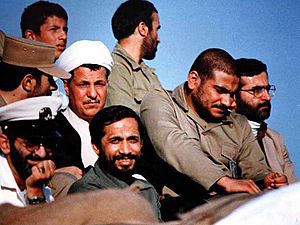
During his time as president, Rafsanjani worked with Supreme Leader Ali Khamenei to keep the government stable after Khomeini's death.
Foreign Policy
Rafsanjani tried to improve Iran's relationships with other countries. He worked to build ties with Arab nations and countries in Central Asia. However, relations with European countries and the United States remained difficult.
He spoke out against both the United States and Iraq during the Gulf War in 1991. After the war, he tried to improve relations with Western countries. Iran also provided humanitarian aid to people affected by the conflict.
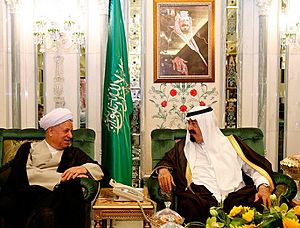
Rafsanjani supported Iran's nuclear program but stated that Iran would not use weapons of mass destruction. He said Iran was ready to give "full assurances" that its nuclear achievements would not be used for military purposes. Many people saw him as someone who could help Iran reach a deal with the West to end economic sanctions.
Rebuilding Iran
After the Iran-Iraq War, Iran needed to rebuild. Rafsanjani's government focused on development and construction. They created the first development plan for the Islamic Republic of Iran.
This plan aimed to rebuild and improve the country's defense, production, and infrastructure. It also focused on improving public culture and creating economic growth. Rafsanjani's government paid a lot of attention to developing industrial and transportation systems.
After Being President
After his presidency, Rafsanjani continued to be an important political figure. In 2000, he ran for Parliament again. He was elected to the Assembly of Experts in 2006, representing Tehran. This body is responsible for choosing Iran's Supreme Leader.
In 2007, he was elected Chairman of the Assembly of Experts. He was re-elected in 2009. However, in 2011, he decided not to run for chairman again.
Rafsanjani also became a supporter of more freedom of expression in Iran. In a speech in 2009, he spoke about the importance of people's votes and the role of the media. Many people attended this speech, showing his continued influence.
2009 Election Protests
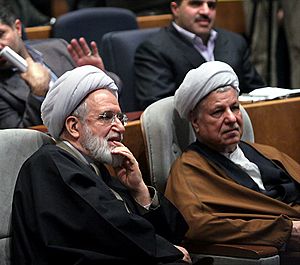
During the 2009 presidential election, there were protests after the results were announced. Rafsanjani's family faced challenges for supporting the opposition. His daughter was even arrested.
Rafsanjani, as chairman of the Assembly of Experts, was in a key position. He spoke publicly about the election crisis and the need for freedom of expression. His support for the Green Movement made him popular among many Iranians who wanted reforms.
2013 Presidential Election
In 2013, Rafsanjani tried to run for president again. However, the Guardian Council did not allow him to stand in the election. He then supported Hassan Rouhani, who went on to win the presidency.
Later Years
In his later years, Rafsanjani continued to support reformers in Iranian politics. He helped moderate forces win the presidential election in 2013 and parliamentary elections in 2016. He was seen as a key figure who could influence the Supreme Leader.
After being re-elected to the Assembly of Experts in 2016, Rafsanjani announced that it would be his last election. He said he could "die with peace of mind" after seeing a more moderate parliament elected.
Death
Akbar Hashemi Rafsanjani died on 8 January 2017, at the age of 82. He passed away due to a heart attack in a hospital in Tehran. The government announced three days of national mourning. Black banners were put up in cities, and some posters showed the Supreme Leader and Rafsanjani together.
After his death, a highway in Northern Tehran was named in his honor. Many other streets and buildings were also named after him, including the central building of Islamic Azad University and Kerman International Airport.
Views
Rafsanjani believed that having political parties was a natural part of society. He thought that Islam did not have a strict rule against parties. He felt that parties were necessary for the revolution to succeed.
Political Parties
Before the Iranian Revolution, Rafsanjani was involved in groups that opposed the Shah. He was connected to the Islamic Coalition and the People's Mujahedin of Iran.
Rafsanjani was a member of the Combatant Clergy Association. He also had close ties to the Executives of Construction Party and the Moderation and Development Party.
He was seen as someone who could work with both conservative and reformist groups. He supported reformers in some elections but also had connections with conservatives.
Islamic Republican Party
Rafsanjani was involved in establishing the Islamic Republican Party shortly after the revolution. He discussed the idea with Ayatollah Khomeini, who initially had doubts but later agreed. The party was officially formed on 17 February 1979. Its goal was to give religious leaders an organized political group. The party received financial support from people's donations and from Khomeini himself.
Electoral History
| Year | Election | Votes | % | Rank | Notes |
|---|---|---|---|---|---|
| 1980 | Parliament | 1,151,514 | ≈54 | 15th | Won |
| 1982 | Assembly of Experts | 2,675,008 | 84 | Won | |
| 1984 | Parliament | 1st | Won | ||
| 1988 | Parliament | 1st | Won | ||
| 1989 | President | 15,537,394 | 96.1 | 1st | Won |
| 1990 | Assembly of Experts | Won | |||
| 1993 | President | 1st | Won | ||
| 1998 | Assembly of Experts | Won | |||
| 2000 | Parliament | 30th | Won but withdrew | ||
| 2005 | President | 1st | Went to run-off | ||
| President run-off | 2nd | Lost | |||
| 2006 | Assembly of Experts | 1st | Won | ||
| 2013 | President | – | Disqualified | ||
| 2016 | Assembly of Experts | 1st | Won | ||
Personal Life
Akbar Hashemi Rafsanjani married Effat Marashi in 1958. They had five children: three sons named Mohsen, Mehdi, and Yasser, and two daughters named Fatemeh and Faezeh.
His daughter Faezeh Hashemi became involved in politics. She was a representative in the Majlis and published a newspaper. Another daughter, Fatemeh, is the President of the Charity Foundation for Special Diseases. His son Mohsen was chairman of the Tehran Metro Organization.
Family Tree
| Mirza Ali | Mah-Bibi Safarian |
||||||||||||||||||||||||||||||||||||||||||||||||||||||||||||||||||||||||||||||||||
| Tayyebeh | Tahereh | Sedigheh | Akbar | Effat Marashi |
Mahmoud | Ahmad | Ghasem | Mohammad | |||||||||||||||||||||||||||||||||||||||||||||||||||||||||||||||||||||||||||
| Fatemeh | Saeed Lahouti |
Mohsen | Azam Hashempour |
Faezeh | Hamid Lahouti |
Mehdi | Fereshteh | Yasser | Maryam Salari |
||||||||||||||||||||||||||||||||||||||||||||||||||||||||||||||||||||||||||
| Sara Lahouti |
Emad | Ehsan | Alireza | Mona Lahouti |
Hassan Lahouti |
Foad | Yasin | Leili | |||||||||||||||||||||||||||||||||||||||||||||||||||||||||||||||||||||||||||
Assets
The Rafsanjani family was well-off. His father was a wealthy businessman with a successful pistachio business. Hashemi and his partners also owned Islamic Azad University, which is a very valuable institution.
Assassination Attempts
Early in his career, after the revolution, Rafsanjani was attacked by gunmen. He was not seriously hurt, and his wife bravely jumped in front of him to protect him. Ayatollah Khomeini famously said, "Great men of history do not die," when Rafsanjani survived the attack.
Books
Rafsanjani was also a writer. Some of his books include:
- Memories
- The Combat Era: This book is about events before the 1979 revolution. It shows his support for Khomeini and other national movements.
- Amir Kabir: the Hero of Fighting against Imperialism (1968)
- Tafsir Rahnama
- Explicit Letters
He also contributed to the Encyclopedia of Quran (Farhang-e-Quran), which explains subjects and concepts from the Quran.
See Also
 In Spanish: Akbar Hashemí Rafsanyaní para niños
In Spanish: Akbar Hashemí Rafsanyaní para niños
- Government of Akbar Hashemi Rafsanjani (1989–97)
- List of Ayatollahs
- List of members in the First Term of the Council of Experts




